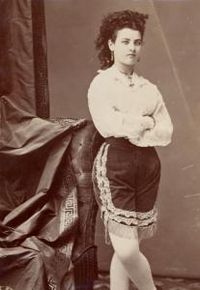Annotation:Kitty O'Neil's Champion
Back to Kitty O'Neil's Champion
KITTY O'NEILL'S CHAMPION. AKA and see "Kitty O'Shea's." American, Dance Tune (2/4 time). A Major. Standard tuning (fiddle). AABBCDDEEFFGG. Despite being called a hornpipe by some modern sources, the tune is classified as a 'jig' in Ryan's/Cole's, a listing that refers to a style of old-time banjo tune, a 'sand jig' and not the Irish jig. The sand jig, according to New York researcher, musician and writer Don Meade (Fiddler Magazine, vol. 8, No. 1, Spring 2001) is a syncopated dance in schottische tempo performed as a series of hard-soled shuffles on a sand-strewn stage. The 'E' and 'F' parts of "Kitty O'Neill's Champion" belong to a tune called the "Mechanics' Hall Jig" (in Ryan), and the 'B' part is similar to 'B' part in "Phil Issac's Jig." The 5th ('E') part also resembles the first part of Ryan's "Bird on the Wing."

Meade finds that Kitty O'Neil (1852?-1893) was born Catherine Connolly, and was a celebrated stage dancer in the latter 19th century. She has been called 'the first American clog dancer', performing primarily in New York in variety theaters on Broadway and the Bowery, but often in Boston as well. She often appeared in shows produced by the renowned entertainers Tony Pastor and Ned Harrigan. In addition to her prowess at Irish reels and Lancashire clog dances, Kitty specialized in dancing the sand jig. There are some minor similarities with the Lewis Brothers old-time tune "Bull at the Wagon." The tune was revived, says Meade, by Donegal fiddler Tommy Peoples in the 1970's (under the title "Kitty O'Shea's"), and has since been recorded by Kevin Burke and others. Perhaps the earliest recording is from 1913 by violinist Charles D'Alamaine, born in 1871 in England, who died in 1943. D'Alamaine immigrated to the United States in 1888, and by 1890 had established himself as "instructor on violin" in Evanston, Illinois; by 1910 he had removed to Yonkers, and in 1920 was a chiropractor in New York City (info. from Paul Gifford).
Source for notated version:
Printed sources: Cole (1000 Fiddle Tunes), 1940; p. 80. Ryan's Mammoth Collection, 1883; p. 112.
Recorded sources:
Back to Kitty O'Neil's Champion
